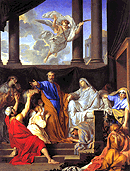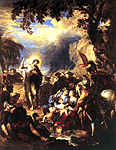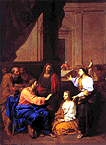La
Salle des Mays de Notre-Dame,

Gallery
in Arras Museum
 "Saint Peter Raising the Widow Tabitha" - the 1652 May, by Louis Testelin (1615-1665). A good example of the painters' desire to express the feelings of the characters portrayed by use of gestures and expression, so that people could "read" the painting. |
Salle des Mays Another painting each year Contribution to the
Counter-Reformation Dispersal of the collection |
|
 Joseph Parrocel (1646-1704), worked in Paris, normally on battle scenes: "The Sermon of Saint John the Baptist" was the 1694 May. The dynamic construction of the painting was greatly admired by other artists - the eye is led from the centurion on the right to St. John on the left, framing the women and children in the middle. |
||
 |
Claude Simpol (1666-1716) worked in Paris, usually on lighter subjects. "Jesus at Martha and Mary's House" in 1704 was one of the last Mays. It is a return to a more classical tradition, with the composition crammed into the lower half of the picture, standing out from a severely plain architectural backdrop. |
|
|
Related background
information |
Places to
visit: |
|
|
|
||
|
Location: Musée des
Beaux-Arts, 22 rue Paul-Doumer, 62000 ARRAS |
|
|
|
|
|
|
|
|
|
|
|
|
|
|
|
|
|
